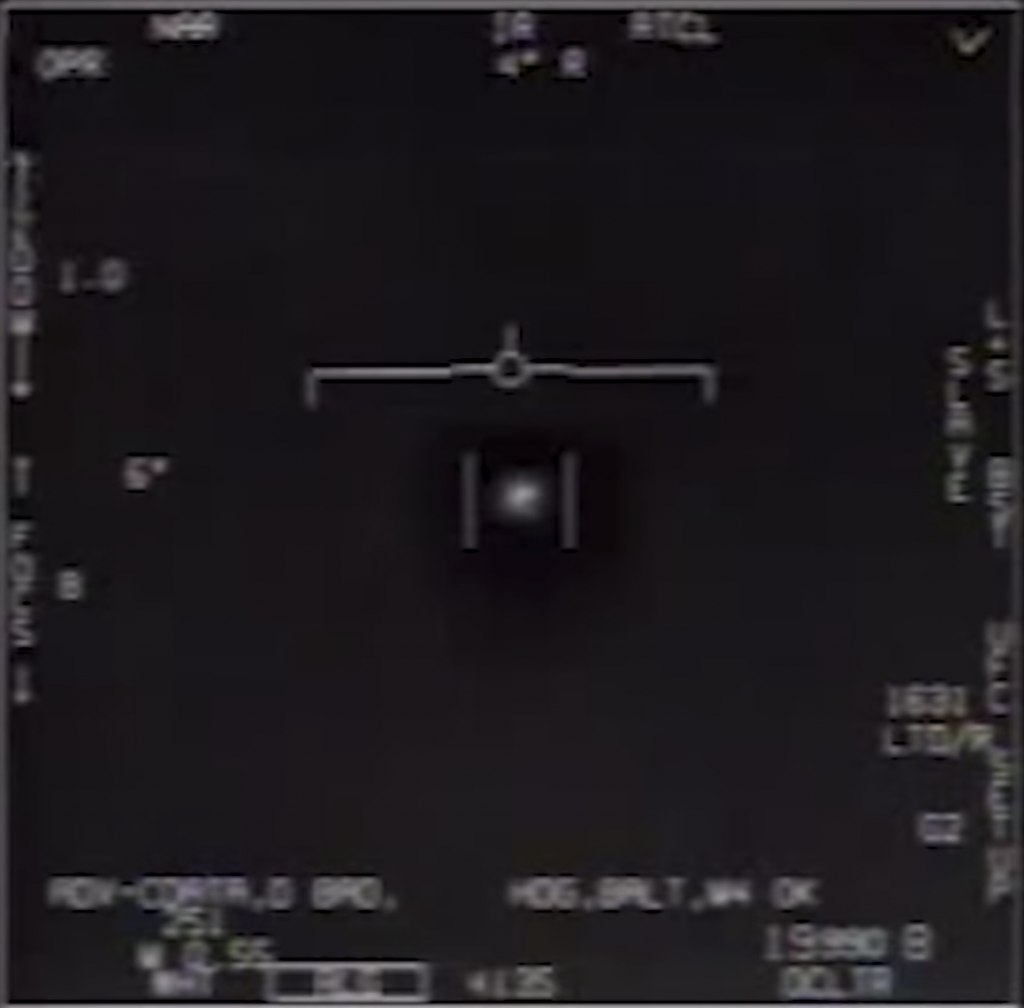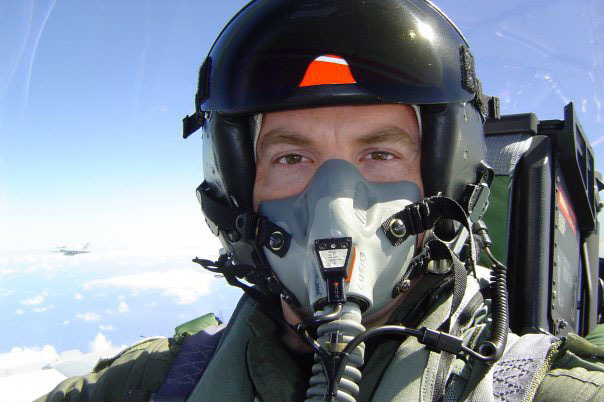12-minute reading time
Matthew Phelan. (2019). Navy Pilot Who Filmed the ‘Tic Tac’ UFO Speaks: ‘It Wasn’t Behaving by the Normal Laws of Physics’. New York Magazine.
In the 15 years since Chad Underwood recorded a bizarre and erratic UFO — now called “the Tic Tac,” a name Underwood himself came up with — from the infrared camera on the left wing of his F/A-18 Super Hornet, he’s become a flight instructor, a civilian employee in the aerospace industry, and a father. But he has not yet spoken publicly about what he saw that day, even now, two years after his video made the front page of the New York Times. As he explained before speaking with Intelligencer, Underwood has mostly wanted to avoid having his name “attached to the ‘little green men’ crazies that are out there.”
The story of the Tic Tac begins around November 10, 2004, when radar operator Kevin Day first reported seeing odd and slow-moving objects flying in groups of five to ten off of San Clemente Island, west of the San Diego coast. At an elevation of 28,000 feet, moving at a speed of approximately 120 knots (about 138 miles per hour), the clusters were too high to be birds, too slow to be conventional aircraft, and were not traveling on any established flight path, at least according to Day.
In a military report made public by KLAS-TV in Las Vegas, Day would later observe that the objects “exhibited ballistic-missile characteristics” as they zoomed from 60,000 feet to 50 feet above the Pacific Ocean, alarmingly without producing sonic booms. All told, radar operators with the Princeton spent about two weeks attempting to figure out what the objects were, a process that included having the ship’s radar system shut down and recalibrated to make sure that the mysterious radar returns were not false positives, or “ghost tracks.”
“The clusters were too high to be birds, too slow to be conventional aircraft, and were not traveling on any established flight path.”
Eventually, David Fravor, commanding officer of the Black Aces, made visual confirmation of one of the objects midair during a flight-training exercise. An hour later, Underwood made his infrared recording on a second flight. “That day,” Underwood recalls, “Dave Fravor was like, ‘Hey, dude. BOLO.’ Like, be on the lookout for just something weird. I can’t remember the exact terms that he used. I didn’t really think much about it at the time. But once I was able to acquire it on the radar and on the FLIR [forward-looking infrared camera], that’s kind of where things — I wouldn’t say ‘went sideways’ — but things were just different.”

Of the three UFO incidents captured by U.S. Navy airmen via infrared gun-camera pods, Underwood’s footage remains unique for its lack of cross talk between the pilots — a fact that has led to some speculation about its authenticity. But “there wasn’t anything of the three UFO incidents captured by U.S. Navy airmen via infrared gun-camera pods, Underwood’s footage remains unique for its lack of cross talk between the pilots — a fact that has led to some speculation about its authenticity. But “there wasn’t anything on it that was protected,” Underwood’s retired former commanding officer Dave Fravor told Intelligencer. The missing audio, he says, “just didn’t make the copy that was taken from the storage drive.”
A former fighter pilot who served on the Nimitz in 2004, who spoke to Intelligencer on condition of anonymity, recalled an exhilarating group screening of the FLIR1 video inside the Nimitz’s Carrier Vehicle Intelligence Center (CVIC): “Debriefs were usually pro forma in the CVIC, but this one in particular was so odd,” the former pilot said. “There weren’t really a lot of skeptics in that room.” Years later, Fravor told ABC News that he didn’t know what the Tic Tac was, but that “it was really impressive, really fast, and I would like to fly it.” In the CVIC that day, the anonymous pilot told Intelligencer, “We all had that. We all wanted to fly it.”
Of the many people to have spotted or recorded the objects, a handful, like Fravor or Princeton’s (retired) Chief Master-at-Arms Sean Cahill, who reported seeing what appeared to be another grouping of the objects from the missile cruiser’s deck, have spoken to journalists or documentarians. Others have not: Lieutenant Colonel “Cheeks” Kurth, a Marine Hornet squadron commanding officer who was also asked to intercept the Tic Tac, still has not done an on-the-record interview. (Three years after the sighting, however, Kurth did take a job as a program manager at Bigelow Advanced Aerospace Space Studies in Las Vegas, whose owner Robert Bigelow has been a well-known private funder of UFO and paranormal research for decades. It was during this same period that Bigelow became a military contractor working on the Pentagon’s once-secret UFO investigation program, the Advanced Aerospace Threat Identification Program.)
Underwood now joins Fravor, Cahill, and others, in speaking about his experience with the Tic Tac. This conversation has been condensed and edited for clarity.
“The objects “exhibited ballistic-missile characteristics” as they zoomed from 60,000 feet to 50 feet above the Pacific Ocean, alarmingly without producing sonic booms.”
What did you think of Dave Fravor’s appearance on the Joe Rogan Experience?
I’m glad Dave went on Joe’s show. He nailed every detail. At the time of the incident, he was essentially my boss, my commanding officer. I was just a pilot in his squadron. Are you familiar at all with how aircraft-carrier air operations work?
So, usually, we fly for about an hour, hour and a half, and then land. Then there’s the next wave of folks that take off and do their mission, blah, blah, blah. That day, Dave Fravor was landing at the same time I was getting my gear on, and we crossed paths just after he’d seen it. I really don’t want to get into what Dave saw because I didn’t see it with my own eyeballs. But I told him, “The Princeton” — again, which has got a really good sophisticated radar — “is reporting that there’s an object out there that they wanted us to see if we could find and, if we’re able, track.”
So, we go out to where our designated training area is. We’re not necessarily looking for something, but the Princeton had a specific object that they wanted us to hunt, for lack of a better word. And all of a sudden, I got this blip on my radar.
The “Tic Tac.”
The term “Tic Tac,” I actually coined that. So, any time you heard the term, “It looked like a ‘Tic Tac’ out there in the sky,” I was the one that kind of coined that.
Was that named based on what you saw with your own eyes, or from looking at the screen on the camera?
No. I was more concentrated on looking at the FLIR. It was inside of 20 miles. You’re not going to see it with your own eyes until probably 10 miles, and then you’re not going to be able to visually track it until you’re probably inside of five miles, which is where Dave Fravor said that he saw it. So, at that point I didn’t see anything with my eyeballs. I was more concerned with tracking it, making sure that the videotape was on so that I could bring something back to the ship, so that the intel folks could dissect whatever it is that I captured.
And it was doing that during your engagement too?
Yes. That was the thing that was the most interesting to me: how erratic this thing was. If it was obeying physics like a normal object that you would encounter in the sky — an aircraft, or a cruise missile, or some sort of special project that the government didn’t tell you about — that would have made more sense to me. The part that drew our attention was how it wasn’t behaving within the normal laws of physics. You’re up there flying, like, “Okay. It’s not behaving in a manner that’s predictable or is normal by how flying objects physically move.”
From looking at the video at the time and more recently, do you get a sense as to how much heat this thing was giving off?
Well, normally, you would see engines emitting a heat plume. This object was not doing that. The video shows a source of heat, but the normal signatures of an exhaust plume were not there. There was no sign of propulsion. You could not see the thing that the ATFLIR pod should pick up 100 percent of the time: the source of heat and exhaust that a normal object flying would give. Does that make sense?
Yeah, it does.
Like, no method of propulsion or exhaust — and the exhaust part of it was the thing that kind of made me raise my eyebrows and be like, “Okay, this is interesting.”
Were you approaching the Tic Tac head-on? Some people have suggested that the Tic Tac’s rapid leftward movement toward the end of the video was actually the result of your F/A-18 banking to the right and dragging the camera along with it.
We were pointed nose-on to it. Maybe 10 to 20 degrees of azimuth, either left or right.
Ergo, when the object kind of darts away to the left—
I was not aggressively maneuvering the aircraft in the manner that would make the FLIR pod would do that. But look: At that point, I did not actually see the object aggressively accelerate to the left, as the video shows, to actually prove that.
Because you were at a distance where you couldn’t make visual contact with your own eyes—
Right.
And so what’s happening in the video is a little ambiguous as a result.
Right. Yeah. And that part kind of sucks, because I can’t confirm that the object aggressively accelerated that way. But I have my feelings, based off of my experience with my equipment — and also just logic, when it comes to, you know, physics.
I want to ask you some questions based on theories that America’s armchair skeptics have put forward — like whether it was birds, or whether it was some sort of thermal weather event. I mean, I’m sure you have had enough flight time that you’ve seen birds.
Yup. Birds normally fly close to the surface of the ground. So, for example, you’re not going to see birds flying at 5,000 feet. You’re going to see them more down at like 2,000 feet and below, like down to the surface. That’s just kind of how birds normally operate. And they’re typically not alone. So you can you can physically see them, in a flock or whatever. You don’t see birds at 5,000 or 10,000 or 20,000 feet. That’s just not how birds operate. So birds are out of the question.
“Definitely not a bird. Not a balloon. Not any type of test aircraft we may not have known about. Not a weather event.”
And just so that I anticipate your next question: There are weather balloons that people launch, but this was not a weather balloon — because a balloon, it just ascends and floats from low to high altitude; it doesn’t behave erratically. I mean, it’s just a damn balloon. So that was out of the question.
It wasn’t — to the best of my knowledge — a cruise missile or any other kind of test aircraft that we possibly may have not known about, just because of the way it was behaving. Like I said, it was just very erratic. It would go from like 50 feet off the ground, which when you’re out in the open ocean, you know, off the coast of San Diego, it looked like it was just hovering over the water. But there was no method of propulsion that was keeping it airborne: no wings, no heat, keeping it airborne or aloft.
Have you ever seen a weather event on an ATFLIR?
I would say if I captured this object on my sensors independently, like I was the only one that saw it or tracked it, I might have blown it off as something like a weather event. But the amount of people and sensors from other independent sources who found it — given the time period Dave Fravor saw it, and an hour and a half later I went out and saw it, and we captured basically an object with the same description — leads me to believe that a weather event would be unlikely.
Did it surprise you or provide any kind of relief seeing the Navy officially declare the Tic Tac video and a genuine UAP when that happened in the Washington Post last September?
No, not surprised. Validation for sure.
This might be a good time to talk about what the mood was on the Nimitz after all of this.
Once I landed, I saw one of my buddies from my sister squadron. He said, “Hey, did you see something out there too?,” in a very jokey manner. And I was like, “Actually, MFer, because I know you want to make fun of me, I got it here on video.” Although, I didn’t say “MFer.” I said the actual term. He’s a good friend of mine, so it was in jest. We pop the tapes into the playback machine. I’m like, “Here, this is where it is.” Those little video cuts— that you see of my FLIR recording — were taken there at the intelligence center. What they do with it from there, I don’t have a whole lot to deal with.
When I was still in my flight gear, so probably within about 20 minutes or so, I spoke to someone that I assume was from NORAD. I described it exactly as I just told you. I didn’t get debriefed.
That never happened, which leads me to think that it was not a government project.
Or, at least, not one—
Not one that they wanted to give any acknowledgment of. And, you know, I’ve got top-secret clearance with a ton of special-project clearances. So, it’s not like I wasn’t cleared to know. But, as I’m sure you’ve found in your research, to have clearance to know something, you have to have both the clearance that it’s elevated to and you have to have the “need to know” it. And, clearly, whatever it was, if it was a government project, I did not need to know.
Yeah. Understood. Here’s something I’m curious about, because of this NORAD aspect: Did it come up that this telephone debriefing was maybe involved with something called an Operations Event Incident Report or NORAD’s OPREP-3 reporting system?
Honestly, Matt, I have no idea. Like what level up to who I was talking to. I just wanted to answer them. I was just basically handed a telephone and said, “Hey. Answer these questions.”
Fair enough. So, between talking to the NORAD guy and Fravor going public, there’s a several-year period where this is just like a thing that happened in your life. Did it come up very often at all?
There would be associations. I would be sitting at lunch five years later with some of my colleagues. Rumors tend to have legs. “Hey, you were out on the Nimitz in ’04. Someone told me about some alien spacecraft.” And I’m like, “Well, (1) the video that you see is my video. And no, I’ve never said that this is what I think it was or speculate as to what I think it was. That’s not my job. But I saw something. And it was also seen, via eyeballs, by both my commanding officer, Dave Fravor, and the Marine Corps Hornet squadron commanding officer who was out there as well.
When did you find out Fravor was going to go public? Did a lot of people approach you during that reporting or afterward?
It’s funny, seeing your boss’s name and face on the news, given what he was putting out there. You know, obviously, our encounter happened in 2004 — so a while back — but everything that Dave has put out there in the interviews is absolutely, 100 percent, exactly what happened on that day. And we’re still good friends to this day, so I started texting him. We had about a two-hour-long phone call and I’d be like, “Dude. Like what made this pop up?” Like, “Where was this like, you know, 12, 14 years ago?” Now it’s 15 years ago. And, I guess, that was when the Pentagon released — whatever project they called it. I can’t even remember it.
AATIP.
Yeah.
Did the New York Times reach out to you? Ask for background just to confirm anything?
No.
Interesting.
Not that I really care.
Yeah.
I’ll let the nerds, like, do the math on what it was likely to be. I just happened to be the person that brought back the video.


